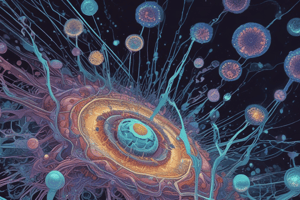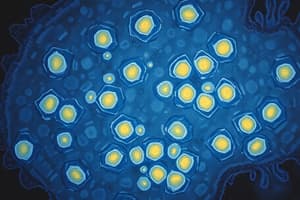Podcast
Questions and Answers
Who was the first to observe living cells?
Who was the first to observe living cells?
- Robert Brown
- Antonie van Leeuwenhoek (correct)
- Theodor Schwann
- Robert Hooke
What is the basic unit of structure for all organisms as per the cell theory?
What is the basic unit of structure for all organisms as per the cell theory?
- Nucleus
- Cell (correct)
- Cell wall
- RNA molecule
Which branch contributed to the development of cell biology by focusing on cellular structure and function?
Which branch contributed to the development of cell biology by focusing on cellular structure and function?
- Botany
- Cytology
- Genetics
- Biochemistry (correct)
What is the term used to describe the process of transferring genetic information from DNA to RNA?
What is the term used to describe the process of transferring genetic information from DNA to RNA?
Which type of RNA carries a genetic message from DNA to ribosomes for protein synthesis?
Which type of RNA carries a genetic message from DNA to ribosomes for protein synthesis?
What is the function of Transfer RNA (tRNA) in protein synthesis?
What is the function of Transfer RNA (tRNA) in protein synthesis?
What discipline merges computer science and biology to make sense of DNA sequencing data?
What discipline merges computer science and biology to make sense of DNA sequencing data?
What is the unit of measurement for molecules and subcellular structures too small to be seen with a light microscope?
What is the unit of measurement for molecules and subcellular structures too small to be seen with a light microscope?
Which technique is used to separate molecules based on size, charge, or affinity?
Which technique is used to separate molecules based on size, charge, or affinity?
Who identified chromosomes during cell division in 1880 and named the process mitosis?
Who identified chromosomes during cell division in 1880 and named the process mitosis?
According to the cell theory, which of the following statements is NOT one of the basic principles?
According to the cell theory, which of the following statements is NOT one of the basic principles?
What is the bearer of genetic information in all organisms?
What is the bearer of genetic information in all organisms?
What process contributed to the acceptance of the double helix model for DNA?
What process contributed to the acceptance of the double helix model for DNA?
Which technique is used to determine the size and composition of proteins or DNA?
Which technique is used to determine the size and composition of proteins or DNA?
What is the function of Transfer RNA (tRNA) in protein synthesis?
What is the function of Transfer RNA (tRNA) in protein synthesis?
What was the possible source of energy for the production of simple organic compounds in Earth's early atmosphere, as suggested by Stanley Miller's experiment?
What was the possible source of energy for the production of simple organic compounds in Earth's early atmosphere, as suggested by Stanley Miller's experiment?
What was the estimated age of our planet when the appearance of primitive cells, involving the encapsulation of 'living' molecules within a simple membrane, is speculated to have occurred?
What was the estimated age of our planet when the appearance of primitive cells, involving the encapsulation of 'living' molecules within a simple membrane, is speculated to have occurred?
What were the initial conditions of the first atmosphere on our planet, based on the text?
What were the initial conditions of the first atmosphere on our planet, based on the text?
What distinguishes a eukaryotic cell from a bacterial or archaeal cell?
What distinguishes a eukaryotic cell from a bacterial or archaeal cell?
Which cellular feature is unique to eukaryotic cells and not present in bacterial or archaeal cells?
Which cellular feature is unique to eukaryotic cells and not present in bacterial or archaeal cells?
Which group of bacteria exhibits extensive internal membranes for photosynthetic reactions?
Which group of bacteria exhibits extensive internal membranes for photosynthetic reactions?
What is the significance of the discovery of ribozymes in the 1980s?
What is the significance of the discovery of ribozymes in the 1980s?
What was the role of Montmorillonite in early life forms?
What was the role of Montmorillonite in early life forms?
What did the pioneering work by Carl Woese, Ralph Wolfe, and colleagues reveal in the 1970s?
What did the pioneering work by Carl Woese, Ralph Wolfe, and colleagues reveal in the 1970s?
Flashcards are hidden until you start studying
Study Notes
-
A micrometre is a unit of length equivalent to one millionth of a meter.
-
Bacteria are typically a few micrometres in diameter, while plant and animal cells are larger.
-
Organelles such as mitochondria and chloroplasts are also a few micrometres in size.
-
The nanometre is the unit of measurement for molecules and subcellular structures too small to be seen with a light microscope.
-
Ribosomes have a diameter of about 25 to 30 nm, while other structures such as cell membranes, microtubules, microfilaments, and DNA molecules are measured in nanometres.
-
The light microscope, which uses white light, played a significant role in identifying membrane-bounded structures in cells.
-
The electron microscope, which uses a beam of electrons, offers greater resolution and can show structures not visible with a light microscope.
-
The Calvin Cycle is the most common pathway for photosynthetic carbon metabolism.
-
Subcellular structures and macromolecules can be separated using centrifugation and the ultracentrifuge, which operates at high speeds.
-
Chromatography is a technique used to separate molecules based on size, charge, or affinity.
-
Electrophoresis separates proteins or DNA, and mass spectrometry determines their size and composition.
-
Mendel's studies of pea plants, published in 1866, established the principles of segregation and independent assortment of genes.
-
Walther Flemming identified chromosomes during cell division in 1880 and named the process mitosis.
-
Chromosomes were later recognized as a distinct species characteristic and showed constancy from generation to generation.
-
Mendel's findings were rediscovered in 1900 by Correns, von Tschermak, and de Vries, leading to the formulation of the chromosome theory of heredity.
-
The discovery of DNA by Miescher in 1869 paved the way for understanding the molecular basis of heredity.
-
Avery, MacLeod, and McCarty's 1944 experiment provided evidence that DNA is the genetic material.
-
Rosalind Franklin's X-ray diffraction images and Crick's central dogma hypothesis led to the acceptance of the double helix model for DNA structure and function.
-
A micrometre is a unit of length equivalent to one millionth of a meter.
-
Bacteria are typically a few micrometres in diameter, while plant and animal cells are larger.
-
Organelles such as mitochondria and chloroplasts are also a few micrometres in size.
-
The nanometre is the unit of measurement for molecules and subcellular structures too small to be seen with a light microscope.
-
Ribosomes have a diameter of about 25 to 30 nm, while other structures such as cell membranes, microtubules, microfilaments, and DNA molecules are measured in nanometres.
-
The light microscope, which uses white light, played a significant role in identifying membrane-bounded structures in cells.
-
The electron microscope, which uses a beam of electrons, offers greater resolution and can show structures not visible with a light microscope.
-
The Calvin Cycle is the most common pathway for photosynthetic carbon metabolism.
-
Subcellular structures and macromolecules can be separated using centrifugation and the ultracentrifuge, which operates at high speeds.
-
Chromatography is a technique used to separate molecules based on size, charge, or affinity.
-
Electrophoresis separates proteins or DNA, and mass spectrometry determines their size and composition.
-
Mendel's studies of pea plants, published in 1866, established the principles of segregation and independent assortment of genes.
-
Walther Flemming identified chromosomes during cell division in 1880 and named the process mitosis.
-
Chromosomes were later recognized as a distinct species characteristic and showed constancy from generation to generation.
-
Mendel's findings were rediscovered in 1900 by Correns, von Tschermak, and de Vries, leading to the formulation of the chromosome theory of heredity.
-
The discovery of DNA by Miescher in 1869 paved the way for understanding the molecular basis of heredity.
-
Avery, MacLeod, and McCarty's 1944 experiment provided evidence that DNA is the genetic material.
-
Rosalind Franklin's X-ray diffraction images and Crick's central dogma hypothesis led to the acceptance of the double helix model for DNA structure and function.
-
Miller's experiments in the 1950s detected glycine and alanine after a week of operation, suggesting possible formation of organic compounds essential for life under abiotic conditions
-
RNA is a key component in present-day cells, with DNA monomers derived from ribonucleotides, implying RNA's role in abiotic systems
-
Discovery of ribozymes in the 1980s: RNA molecules that fold into shapes catalyzing chemical reactions, supporting the "RNA world" hypothesis
-
Liposomes are artificial structures made from lipids similar to cellular membranes; they can reproduce, increase in size, and carry out simple metabolic reactions
-
Montmorillonite, a mineral clay derived from volcanic ash, may have played a role in the trapping of RNA into vesicles, forming the first "protocells"
-
Traditional distinction between prokaryotes and eukaryotes: prokaryotes lack a true, membrane-bound nucleus, whereas eukaryotes have one
-
Pioneering work by Carl Woese, Ralph Wolfe, and colleagues in the 1970s revealed that the so-called prokaryotes actually include two distinct groups: bacteria and archaea
-
Three domains of life: bacteria, archaea, and eukarya; the bacteria include most non-nucleated organisms, while archaea have diverse metabolic strategies and inhabit extreme environments
-
Cell size is limited by the requirement for an adequate surface area/volume ratio, diffusion rates, and the need to maintain adequate local concentrations of essential substances.
Studying That Suits You
Use AI to generate personalized quizzes and flashcards to suit your learning preferences.




